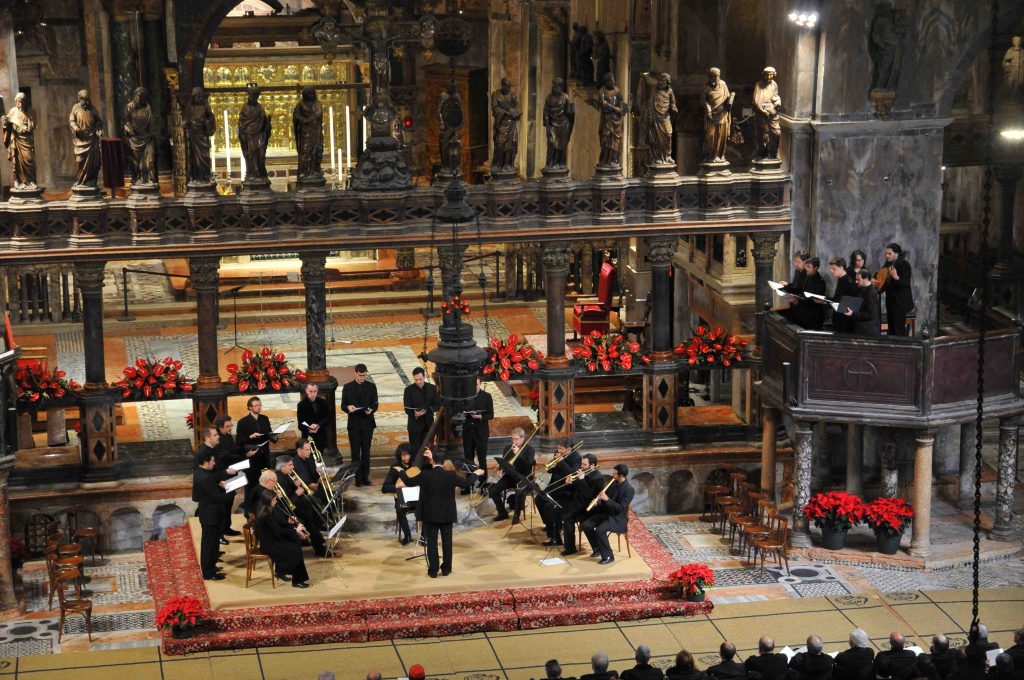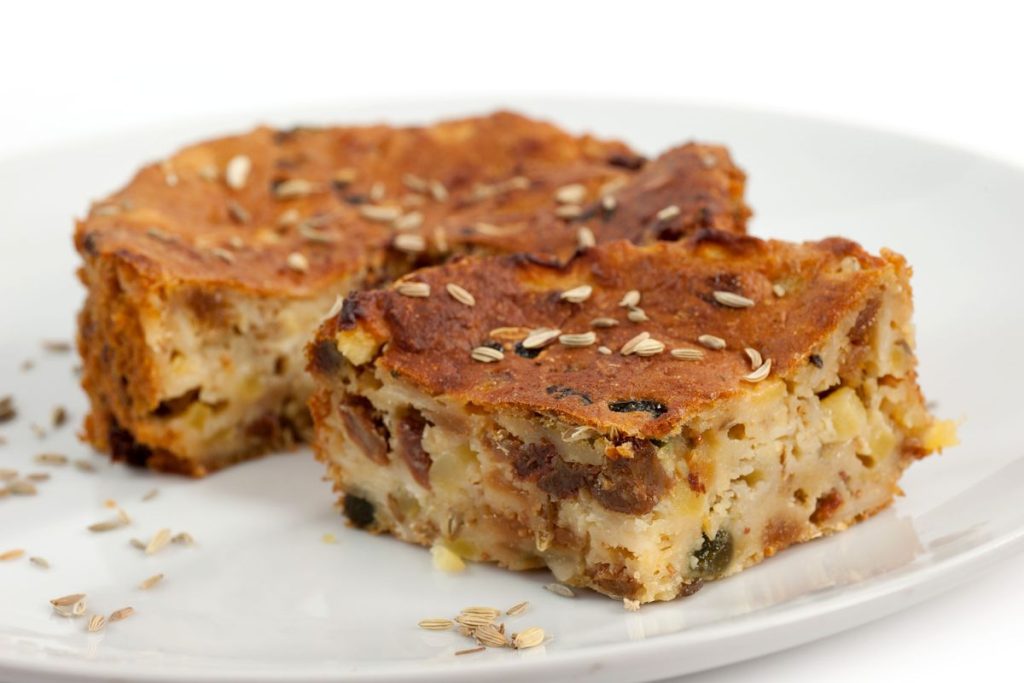
The gateway to the city
By Rachele Callegari
Getting off the vaporetto and heading toward St. Mark’s Square, it is impossible not to be struck by the grandeur of the Procuratie, which embrace the square on three sides, delimiting it in the area in front of St. Mark’s Basilica. So named because in ancient times they were the residence of the procurators of St. Mark’s, they are divided into three wings: the Procuratie Vecchie to the north, the Napoleonic Wing to the west, and the Procuratie Nuove to the south.
The Procuratie Vecchie extend for 152 m, from the Clock Tower westward, with a portico formed by fifty arches, surmounted by one hundred windows placed on the two upper floors. Although characterized by round arches, the openings appear very light and are reminiscent of the first procuratie in the Venetian-Byzantine style, built in the 12th century under the dogeship of Sebastiano Ziani. These were damaged by fire in the early 16th century and later demolished to make way for the new ones, completed in 1538 with the contribution of Jacopo Sansovino.
Shortly afterwards, in 1583, construction of the Procuratie Nuove was begun by Vincenzo Scamozzi. Rising on the area of some earlier buildings, they were aligned with the Libreria Sansoviniana, whose architecture they in fact continued. Their construction ended in 1640 under Baldassarre Longhena. During the Kingdom of Italy they assumed the function of the Royal Palace, an attribution they retained until 1946. Today they house part of the Correr Museum, the Museum of the Risorgimento, the Archaeological Museum, the Directorate of Civic Museums and part of the Biblioteca Marciana, as well as the well-known Caffè Florian.
The last section of the Procuratie is the section that closes them in a horseshoe shape. This section is called Napoleonic because it was Napoleon who wanted it built, having the Church of San Geminiano, which was located in that area, torn down. One of the oldest churches in Venice, attested as early as the 6th century, it had been renovated by Sansovino, who was buried in an adjacent chapel with his sons. Between 1807 and 1810, the entire complex was demolished to the design of architect Eugene de Beauharnais, who wanted to enrich the Royal Palace with a ballroom overlooking the “most beautiful drawing room in the world. The project was entrusted to Giuseppe Maria Soli, who took up the style of the Procuratie Nuove; the building was completed in 1922 during the Austrian Empire.
It was precisely from the Procuratie that the “Christmas of Light 2021” project began: illuminations were installed all along the Procuratie and along Calle XXII Marzo to Campo Santa Maria del Giglio, thus lighting up the gateway to Venice and the shopping routes in the sestieri of Santa Croce, Cannaregio, San Polo, Dorsoduro, San Marco and Castello. The light displays will act as a guide inside the city, among campi and campielli, to discover Venetian craft stores and all the commercial activities. The lights will remain on until March 1, 2022, the last day of Carnival.
Did you know that …
On the occasion of Christmas 2018, a tree made entirely of blown glass, more than 8 m high and composed of more than 1,000 polychrome tubes was inaugurated in Murano Still today it is possible to admire the work of master glassmaker Simone Cenedese.
Discovering Venice through our 5 senses

View
MARKETS IN CAMPO SANTO STEFANO
During the weeks of Advent and then the holiday season, Campo Santo Stefano is transformed into a Christmas village. Thirty little wooden houses populate the square, and artisans and food producers sell their wares in an almost fairy-tale atmosphere given by the setting of the Venetian palaces that stand out behind the market. Sponsored by the Artisans Association, it is decked out with Murano glass decorations, carnival masks and Venetian craft specialties. It is definitely the city’s main market and offers not only crafts and food and wine: musical events and workshops are organized for children of all ages, as well as the presence of an ice skating rink. The festive atmosphere is accentuated by musicians and artists of all sorts who entertain the public at all hours. Located in the Dorsoduro sestiere, the square is the ideal place where Venetians and tourists meet mingling.

Hearing
THE CAPPELLA MARCIANA
This is one of the oldest musical institutions still operating today, belonging to a tradition of great composers starting with the Cantores Sancti Marci, attested since the early 14th century. The Cappella Marciana is nothing less than a great musical workshop that, with its enormous volume of liturgies, represents a worldwide unicum.
After the consecration of St. Mark’s Basilica in 1094, the first record of musical activity occurs in 1316. Over seven hundred years of musical activity have seen the succession of important chapel masters, up to the current one, Marco Gemmani, who has led the Basilica Chapel since 2000. Just since the end of the nineteenth century, the masters have begun a work to recover the oldest heritage, to keep alive the enormous musical treasure formed over time. One of the latest projects, in the run-up to Christmas, was the publication of “Christmas Mass in St. Mark 1685,” nominated for the International Classical Music Awards 2022.

Taste
PINZA
The night of Epiphany Eve is better known in the Veneto region as the night of “Panevìn.” Tradition has it that piles of dry branches, corn canes and brushwood are prepared and put together to form a pyramidal structure. Afterwards, the piles are burned and depending on the progress of the sparks, a prediction is made about the year that has just begun. Panevìn ends with the consumption of pinza cooked under the ashes as described in an ancient recipe: “With cornmeal, over which boiling water is poured: when it has cooled a little, wheat flour is added, everything is kneaded together and then wrapped in cabbage leaves verzotti is cooked on the ariola covering it with ashes.” It is nothing more than a sweet made of flour, raisins and pine nuts, which takes on the same meaning in this ritual as the exchange of bread once did among poor rural people. And no self-respecting pinza is complete without a glass of mulled wine.

Olfaction
A UNIQUE BOOKSTORE
Not far from San Marco and the Rialto Bridge, on Calle Longa Santa Formosa in the Castello district, we find Libreria Acqua Alta. Its peculiarity is the fact that the books are not placed, as is the norm, inside shelves or racks, but are stored in alternative furnishings, such as bathtubs or gondolas, precisely to protect them from the phenomenon of high water that cyclically strikes the San Marco area. The titles that can be found are mostly second-hand or out-of-print: the beauty of this bookstore also lies in the scent of pages printed years and years ago that hits anyone who enters. Not only more and less antique books, used and not, the bookstore in fact also sells vinyls and various kinds of objects. The books also have been transformed into real furniture objects: famous is the staircase formed by old encyclopedias above which it is a must to climb to take a picture. Completing the picture, already characteristic in itself, are the numerous cats sleeping among the stacked books.

Tatto
SAN POLO FIELD.
Campo San Polo is the second largest campo in Venice, a primacy held, of course, by St. Mark’s Square. It owes its name to the church of San Polo, which still stands in one corner of the square. Originally, the area had been used as a cultivable area suitable for grazing animals; in 1493, however, it was entirely paved over and the place became a center of markets and fairs. It assumed increasing importance, so much so that during the seventeenth century it became the site of the poor man’s markets, previously located in San Marco. It thus obtained an almost exclusively recreational, leisure identity: public festivals and games, often very chaotic and violent, were held there. The situation reached its peak in 1611, when all games and the sale of merchandise were banned, as evidenced by a plaque still visible today on one of the church walls.
Every year at Christmas, the field hosts a large ice skating rink that remains open until March. Completing the Christmas atmosphere is a large horse-drawn carousel present nearby.
Did you know.
On the occasion of Christmas 2018, a tree made entirely of blown glass, more than 8 m tall and composed of more than 1,000 polychrome tubes was inaugurated in Murano You can still admire the work of master glassmaker Simone Cenedese today.







